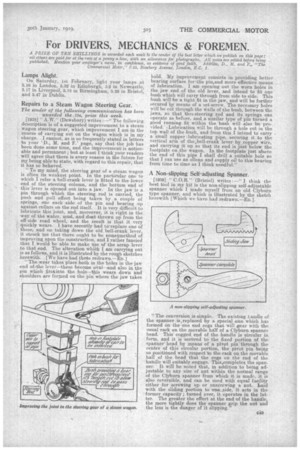For DRIVERS, MECHANICS & FOREMEN.
Page 21

If you've noticed an error in this article please click here to report it so we can fix it.
A PRIZE OF TEN SHILLINGS is awarded each week to the sender of the best letter which we publish on this page:
• all others are paid for at the rate of a penny a line, With an allowance for photographs. AU note; are edited before being published. Mention your employers name, in confidence, as evidence of good faith. Address, D., N. and P., "The Commercial Motor," 7-15, Rosebery Avenue, London, E.C. 1.
Lamps Alight.
On Saturday, 1st February, light your lamps at 6.16 in London, 6.32 in Edinburgh, 5.2 in Newcastle, 5.17 in Liverpool, 5.18 in Birmingham, 5.26 in Bristol, and 5.47 in Dublin.
•
Repairs to a Stearn Wagon Steering Gear.
The sender of the following communication has been awarded the .10s. prize Ws weds.
[1938] " LW." (Dewsbury) writes The following description is of a 'suggested improvement to a steam wagon steering gear, which improvement I am in the course of carrying out on the wagon which is in my charge. I cannot, as is so frequently stated in letters to your ' D., M. and F.' page, say that the job has been done some time, and the improvemenVis noticeable and permanent ; but at least 1 think your readers will agree that there is every reason in the future for my being able to state, with regard to this repair, that it has so behaved.
"To my mind, the steering gear of a steam wagon is often its weakest point. In the particular one to which I refer a bell-crank lever is fitted to the lower end of the steering column, and the bottom end of this lever is opened out into a jaw. In the jaw is a pin through which the .steering rod is earned, the push •and pull effect being taken by a couple of springs, one each side of the pin and bearing up against collars on the rod itself. It is very difficult to lubricate this joint, and, moreover, it is right in the • way of the water, mud, and duet thrown up from the off-side road wheel, and the result is that it very quickly wears. I have recently had to,replace one of these, and on taking down the old, bell-crank lever, it struck me that -there ought to be sometmethod of improving upon the construction, and I rather fancied that I Would be able to make use of the scrap lever to that end. The alteration which I am carrying out is as follows, and it is illustrated by the rough sketches herewith. [We have had theSe redrawn.—En. . " The•wear takes place both in the-holes in the jaw end of,the lever—these become oval—and also in the .pin which .fitsilinto the hole—this wears down and shoulders are formed on the pin where the jaw takes hold. My improvement consists in providing better bearing surface forthe pin,and more effective means of lubrication. I am opening out the worn holes mu the jaw end. of the old lever, and intend to fit one bush which will carry through from side to side. This bush will be a tight fit in the jaw, and will be further secured ky means of a set-screw. The necessary holes will be cut through the Walls of the bush, between the jaws, so that 'the* steering rod and its springs can operate as before, and a similar type of pin turned a good running fit within the bush will also be provided. ;Lubrication will be through a hole cut in the top wall of the bush,. and from this I intend to carry a small copper :lubricating pipe, securing it to the vertical arm of the;bell-crank lever by copper wire, and carrying it up so that its end is just below the footplate on ,the wagon. In the footplate just above the end of this pipe I shall drill a suitable hole so that I can use an oilcan and supply oil to this bearing from time to time as I think needful."
A Non-slipping Self-adjusting Spanner.
[1939] " C.O.B." (Bristol) writes :—" I think the best tool in my kit is the non-slipping self-adjustable spanner which I made myself from an old Clyburn type spanner, and which is illustrated by the sketch herewith [Which we have had redrawn.—En.].
"The conversion is simple. The existing handle of the spanner is,replaced by a special one which has formed on the one end cogs that will gear with the usual rack on the movable half of a Clyburn spanner head. This cogged end of the handle is circular in form, and it is secured to the fixed portion of the spanner head by nipani of a pivot pin 'through the centre of this circular portion, the pivot pin being so positioned with respectto the-rack on the movable half of the head that the cogs on the end of the handle will suitably engage. This,completes the spanner. It will be noted that, in addition to being adjustable to any size of nut within the normal range of the Clyburn spanner from which it is made, it is also reversible, and can be used with equal facility either for screwing up or unscrewing a nut. Laid with the sliding portion to anaside, it acts in the former capacity ; turned over, it operates in the latter. The greater the effort at the end of the handle, the more tightly does the spannergrip the nut and the less is the danger of it slipping.'






















